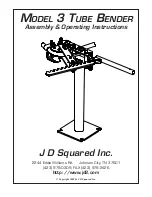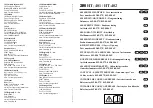
BRAKE AND CLUTCH BLEEDING SYSTEM
model no:
VS820.V4
Thank you for purchasing a Sealey product. Manufactured to a high standard, this product will, if used according to these
instructions, and properly maintained, give you years of trouble free performance.
IMPORTANT:
PLEASE READ THESE INSTRUCTIONS CAREFULLY. NOTE THE SAFE OPERATIONAL REQUIREMENTS, WARNINGS & CAUTIONS. USE
THE PRODUCT CORRECTLY AND WITH CARE FOR THE PURPOSE FOR WHICH IT IS INTENDED. FAILURE TO DO SO MAY CAUSE DAMAGE AND/OR
PERSONAL INJURY AND WILL INVALIDATE THE WARRANTY. KEEP THESE INSTRUCTIONS SAFE FOR FUTURE USE.
1. SAfETY
WARNING!
Familiarise yourself with the application and limitations, as well as any potential hazards, of this product. ensure that Health
and Safety, local authority and general workshop practice regulations are adhered to when using.
8
DO NOT
use pressure reservoir, or its ancillaries if damaged.
8
DO NOT
use the pressure reservoir to perform a task for which it is not designed.
8
DO NOT
allow untrained persons to use the pressure vessel.
8
DO NOT
use when tired or under the influence of drugs, alcohol or intoxicating medication.
9
Use approved parts and approved spare parts only.
9
maintain in a good and clean condition for the best and safest performance.
9
ensure that the ignition key of the vehicle being worked on is removed, to prevent inadvertent engine cranking.
9
If the vehicle to be worked on is raised, ensure that it is adequately supported with axle stands or ramps and wheel chocks.
9
Wear approved eye protection. A full range of personal safety equipment is available from your Sealey stockist .
9
Wear suitable clothing to avoid snagging.
DO NOT
wear jewellery and tie back long hair.
9
Keep children and unauthorised persons away from the work area.
9
Keep work area clean and tidy and free from unrelated materials.
9
ensure the work area has adequate lighting.
1.1.
BRAKE fLUID SAfETY
9
Always read and comply with the warnings on the brake fluid container.
9
Wear eye protection and keep skin contact to a minimum. If brake fluid enters eyes rinse with plenty of water and seek medical
advice. If swallowed seek medical advice immediately.
WARNING!
Brake fluid is flammable - keep away from sources of ignition, including hot surfaces e.g. exhaust manifold.
WARNING!
Brake fluid will damage paintwork. Any spillage should be flushed with water immediately.
9
Always read and comply with the warnings on the brake fluid container.
WARNING!
DO NOT
pollute the environment by allowing uncontrolled discharge of fluids. Dispose of waste liquids in accordance
with local authority regulations.
9
After use, clean equipment and store in a cool, dry, childproof area.
2. INTRODUCTION
one man brake and clutch bleeding the professional way. Bleeding requires no external power source - simply fill and pump. The reservoir holds
2.5ltr of hydraulic fluid - flush the entire system flush in one fill without running the risk of running the reservoir dry. Pressure range makes the unit
suitable for use with ABS systems. Fitted with a Ø45mm cap with 90° angled connector which is suitable for most european models. For other
applications order optional Ø45mm Straight Connector - model no. VS820SA, Universal Adaptor - model no. VS820UA and Bleeder Cap Set -
model no. VS0204B.
3. OpERATION
Use your bleeder only as directed. Read these directions completely before starting. The apparatus is intended for use only by individuals
experienced with bleeding and servicing hydraulic systems. If you are unsure about your ability or experience, consult a trained professional.
Always follow vehicle manufacturer’s directions when bleeding hydraulic systems.
3.1.
Ensure that the bleeder is clean and free from debris and old hydraulic fluid.
3.2.
Remove hydraulic fluid reservoir cap from the vehicle. If old fluid is contaminated, syphon it off and refill reservoir with fresh fluid.
8
DO NOT
pump contaminated fluid through the hydraulic system.
3.3.
Firmly attach the bleeder cap to the vehicle fluid reservoir, ensuring that the gasket seats properly and is not worn or cracked.
3.4.
Tighten pump cap onto empty bleeder and pressurise to 10 psi (0.7bar). Check for leaks at the fluid reservoir and at the bleeder fluid
hose connections. If reservoir cap or hose connections are leaking, release accumulated pressure in the bleeder reservoir by gently
unscrewing the pump cap.
DO NOT
remove the cap before de-pressurising the bleeder reservoir. Reattach the bleeder reservoir cap
or tighten hose connections and once again pump the tank to 10 psi (0.7bar) and check for leaks.
3.5.
If no leaks are found, gently unscrew pump cap and add up to 1.25 litre of new hydraulic fluid from a sealed container. Use only the
type of hydraulic fluid recommended for your vehicle.
3.6.
Tighten the pump cap and pressurise the bleeder to the level recommended in the vehicle service manual.
DO NOT
exceed 28psi
(1.9bar). Higher pressures may damage your vehicles hydraulic system and could result in serious injury.
Original Language Version
© Jack Sealey limited
Refer to
instructions
Wear eye
protection
VS820.V4 Issue 3 (2) 17/09/18




















